How to Create a Table of Contents for an Employee Handbook
An employee handbook covers everything from your company culture to day-to-day policies and information related to legal compliance. A good employee handbook reduces uncertainty, maintains consistency, and helps resolve conflict.
A table of contents makes your employee handbook easy to navigate. Even better, an electronic or digital employee handbook can include a table of contents with clickable links, making it even easier for employees to navigate to the specific information they need.
By the end of this article, you should know why you need a table of contents and how to create one.
Why Your Employee Handbook Needs a Table of Contents
Before we talk about what you need to put in your table of contents, let’s understand why a table of contents is so important. An effective table of contents transforms your handbook from an overwhelming policy document into a helpful resource that’s easy to navigate.
When developing your employee handbook, it’s important to research the topics you need to cover. Once you’ve got a good idea of the content you’ll include, you should organize it in a logical way to ensure similar topics are grouped together. As you do this, you’re not only determining what content you need — you’re creating your table of contents.
Employee handbooks vary in size depending on the organization’s size, growth stage, and office locations. No matter the length of your handbook, an employee should be able to quickly locate what they’re looking for.
A clunky, physical handbook isn’t just difficult to use — it can also undermine sustainability efforts if new copies need to be printed every time updates are made. An electronic or digital employee handbook makes your table of contents more helpful, allowing easy navigation with a single click.
Tips for Creating an Organized Employee Handbook
Organizing your employee handbook helps make a wealth of information easier to understand. The table of contents, the first piece of this structure, guides how an employee approaches the handbook.
Here are some additional tips and tricks for bringing out the best in your handbook.
Use Topics and Subtopics
Using topics and subtopics in your table of contents makes it easier for employees to cut through the noise.
Similarly, you should use consistent headings and subheadings within the content for a more reader-friendly handbook. For maximum effectiveness, keep the language simple and concise. Think from the perspective of an employee facing an issue and what they might be looking for when scrolling through the handbook.
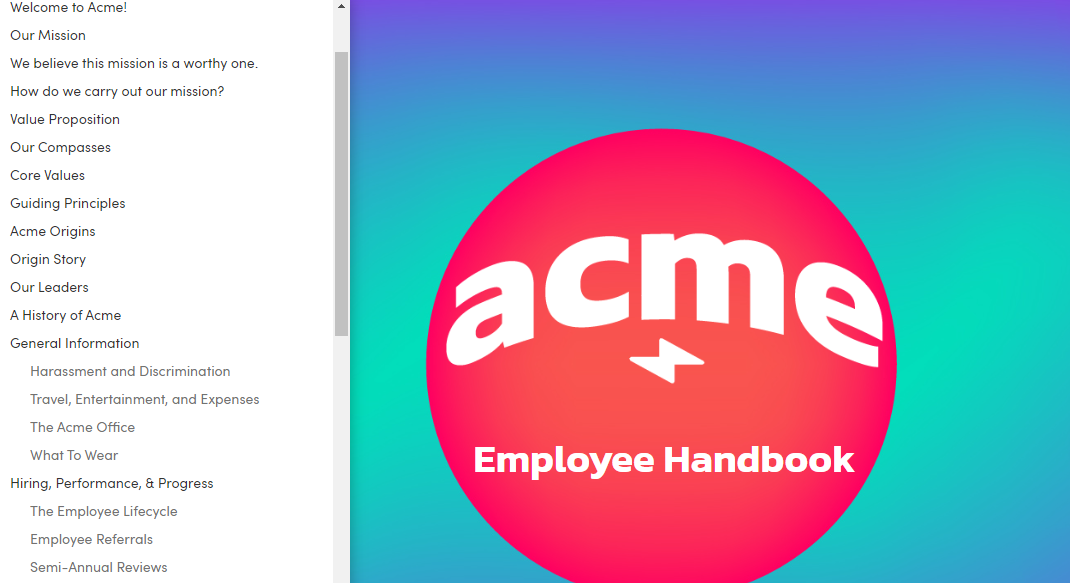
Follow a Logical Order
Your handbook and its table of contents should be in a logical and sequential order. For example, your company’s mission and vision, values, and other cultural content, should be in the beginning. Not only does it help you start with “why — it serves as a hook to grab reader attention. Your cultural content lends itself better to design elements that can provide a wow factor, and it’s content that everyone in your company is interested in reading.
After this, topics should naturally flow from one to the next. It’s not intuitive to have information about paid time off (PTO) in the first section, then details about company holidays at the end. Related information should be grouped together.
When you get to your policies — your whats — you should again start with a hook. Try to ward off an employee thinking, “Oh, here comes the boring part,” by starting with policies that are the most interesting to your employees. That could be your time off policies, other company benefits, tuition reimbursement, or something else entirely. You know your company best!
Make it Visually Appealing
Use consistent styles, fonts, and indentation. The HR team can take a step back while the marketing or communications team works their magic to make the handbook as attractive as possible. You want your handbook to be visually appealing and easy to read.
Bullet points help to organize and synthesize information into easy-to-digest chunks. You can also use graphics, highlighting, and summaries to keep the body of text engaging.
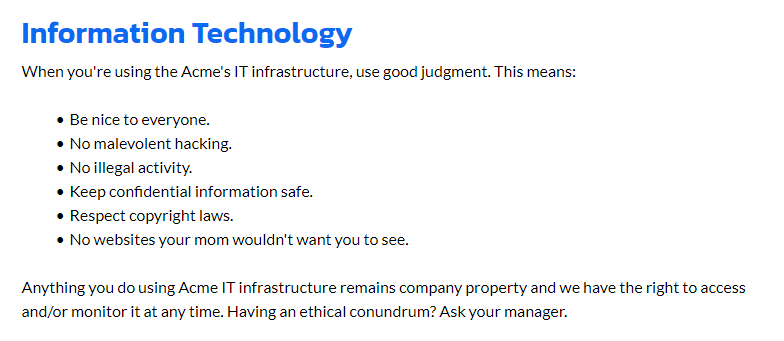
Use Hyperlinks and Search Capabilities
If your handbook is digital, include hyperlinks that make it easy and intuitive to jump around to different sections.
You’ll also want to include a keyword search feature to help employees quickly find specific information.
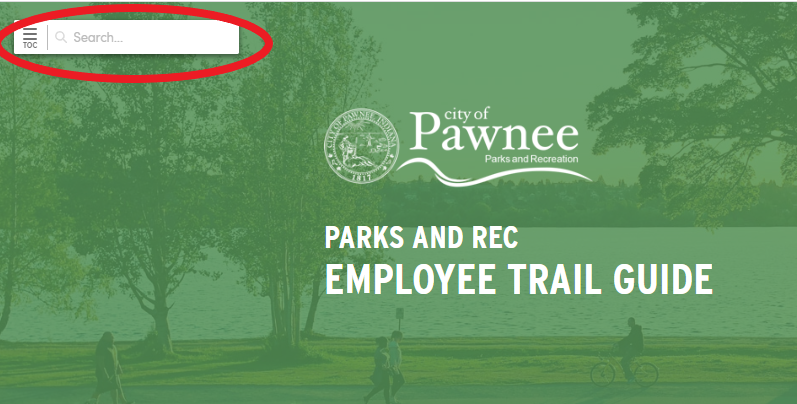
Looking for a shortcut? When you build a handbook using Blissbook, the program automatically creates a customizable table of contents. This means you don’t need to worry about verifying page numbers and assuring everything is listed in the table of contents.
The Key Elements of an Employee Handbook
An employee handbook has a lot of ground to cover, and it’s vital to make sure you haven’t overlooked anything. Here are some sections you should include in your handbook.
Company Culture, Values & Mission
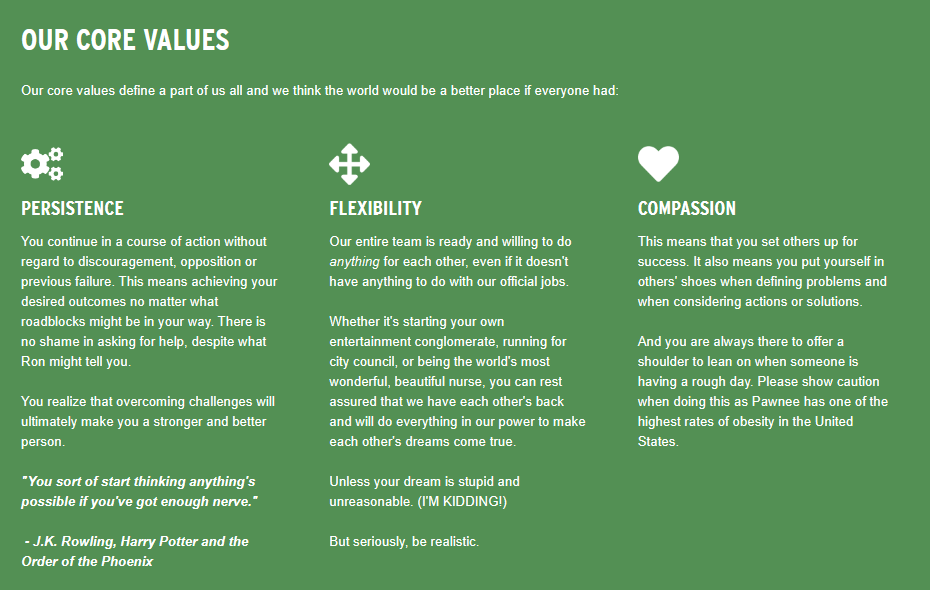
You want to make your handbook useful for new and current employees. This includes making sure everyone understands your culture, values, and mission.
You may even consider including additional background information, like leader profiles, a company timeline, and a welcome statement.
Company Policies & Procedures
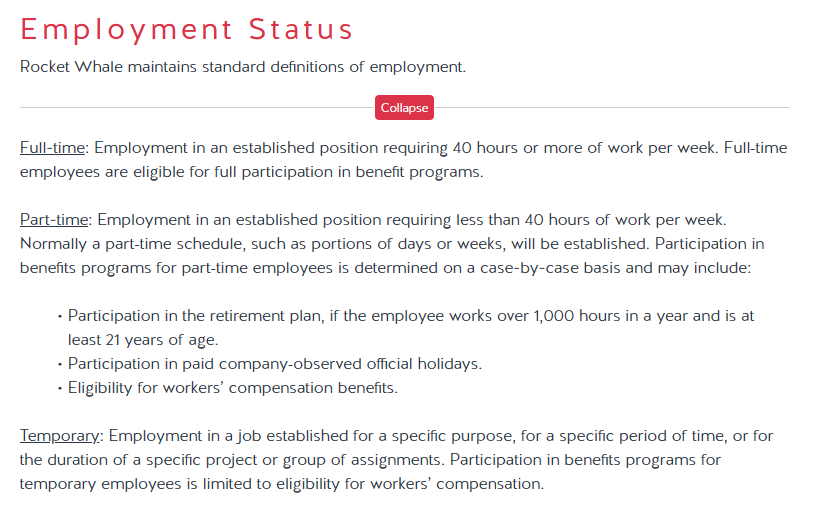
The bulk of the employee handbook should consist of information to guide the day-to-day and long-term behavior of your employees. These employee handbook policies may include:
- A Workspace for All: These policies communicate your company’s commitment to its employees. Example policies include equal employment opportunity, anti-discrimination, and reasonable accommodations related to disabilities and religious practices. You can also share the policies you’ve implemented to ensure a safe workplace, like those that discuss workplace violence, health and safety, and the use of drugs and alcohol.
- Time Off and Leaves of Absence: No matter how awesome your company is, employees will be eager to learn about taking time off. You should provide information on paid time off and company holidays. This is also the ideal place to discuss the not-so-fun reasons for time off, like the Family and Medical Leave Act (FMLA), jury duty, and bereavement leave.
- Benefits: Always highlight your employee benefits! You’ll want to cover information like health insurance, employee assistance programs (EAP), retirement plans, and more. Generally it’s best to include a high-level overview of each benefit, directing employees to the summary plan description for more information. This helps eliminate the need for updates each time a benefit changes.
- Compensation and Performance: Your handbook should include your policies about employee compensation and performance. Consider items like employee classifications, pay periods, timekeeping, overtime, and meal and rest breaks. When it comes to employee performance, you’ll want to discuss the review process, transfer/promotion opportunities, and progressive discipline, to name some examples.
- Office Life: Workplace policies should include details about day-to-day employee expectations around the office (or remote work location). Here you’ll want to include things like dress code expectations, attendance requirements, and acceptable use of technology.
- Business Conduct: Be sure to communicate ethical expectations you have of your employees. This section of policies should include things like your code of conduct, confidential information, outside employment, and what constitutes a conflict of interest.
- Separation of Employment: Don’t lead with this, but you’ll want to include termination-related policies at the end of your handbook. Examples include resignation procedures, final pay details, COBRA benefits continuation, and exit interviews.
Again, start with content that’s most interesting to your employees. And unless you’re in South Carolina, there’s no law that says you need to start with an At-Will Disclaimer.
Relevant Legal Information
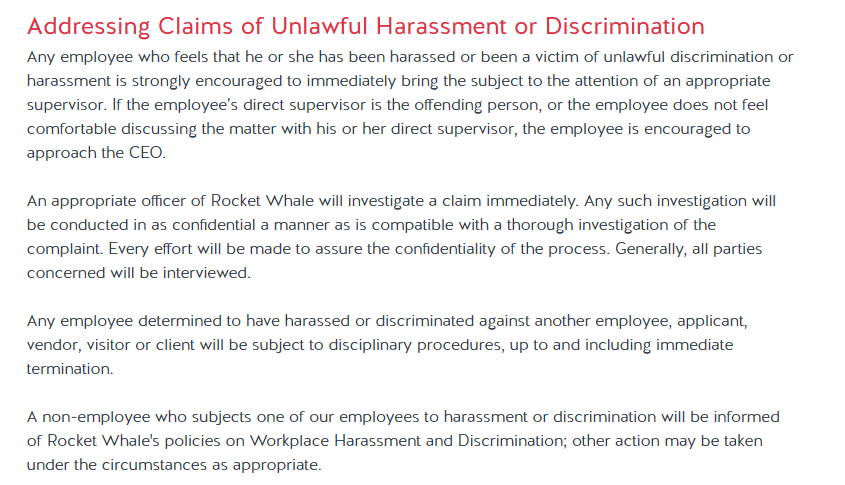
Apart from speaking about culture and benefits, an employee handbook must include relevant legal information to protect your company from lawsuits and penalties.
An at-will employment policy, for example, helps create clear expectations of the terms of employment — indicating that the company or its employees can terminate the relationship at any time, for any reason, without advance notice (barring cases that violate anti-discrimination laws).
Similarly, you need to provide statements related to equal employment opportunity, anti-harassment, and reasonable accommodations for people with disabilities.
Don’t forget to ask employees to acknowledge handbook receipt.
Anytime you’re creating or making changes to your employee handbook, be sure to have a legal professional look over the document and approve it.
Customize Your Employee Handbook Table of Contents Using Blissbook
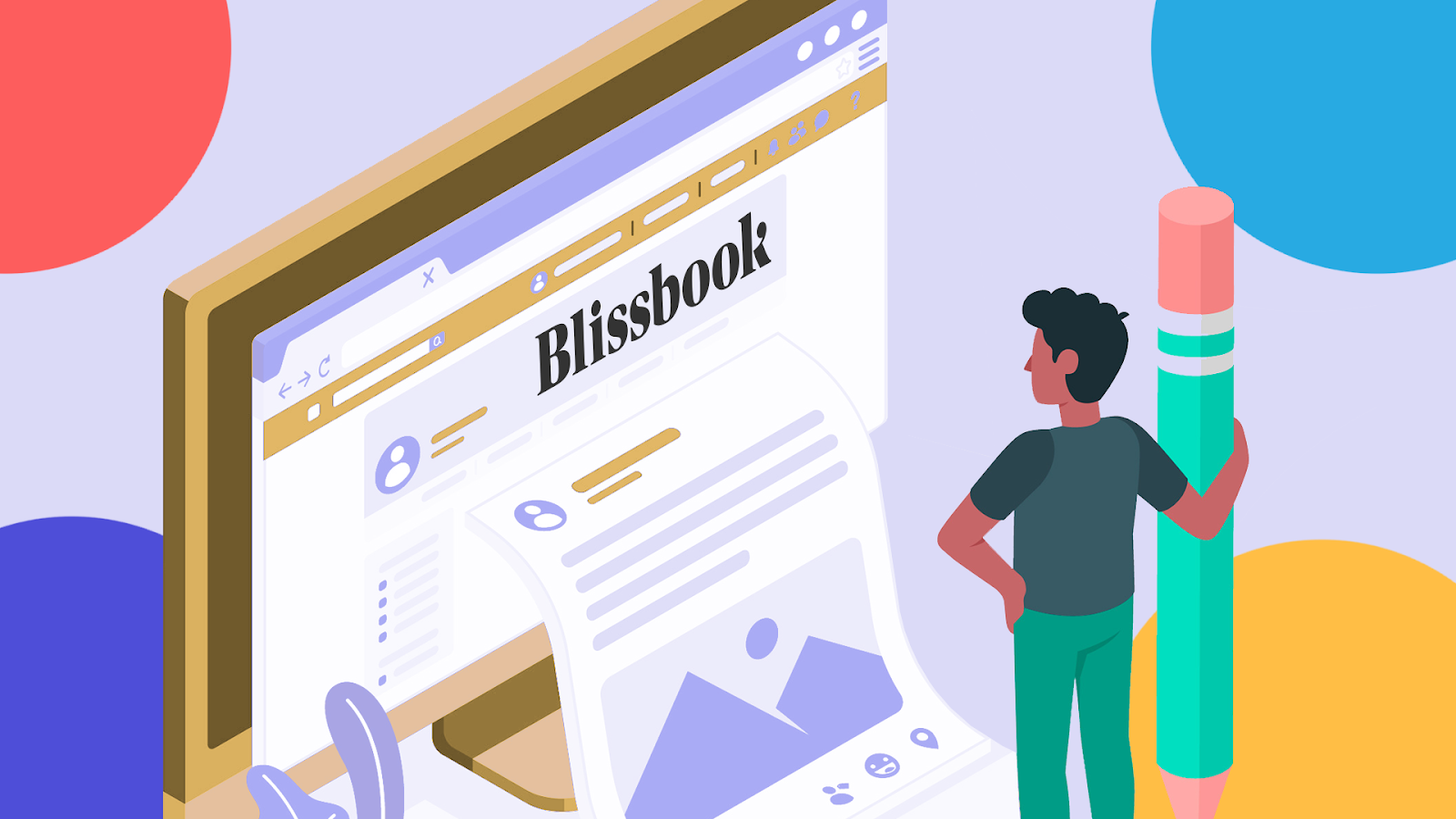
There are limited hours in a workday, so it’s important to take advantage of the resources available to you. Instead of working back and forth on a single, endless Word document, trying to keep track of all the page numbers and shifting content, use a tool to sort it out instead.
Blissbook is an industry-leading platform that makes it easy to incorporate a table of contents into your employee handbook. If you rearrange the order of content while building your handbook, most software requires you to circle back to the front and manually change the corresponding titles and sections. Blissbook does this automatically.
Plus, Blissbook offers a range of features for your employee handbook, including the ability to notify employees of handbook updates and manage electronic signature reporting.
Get in touch with Blissbook today or sign up for a trial for more information on optimizing your employee handbook — whether you’re updating an old one or starting fresh.